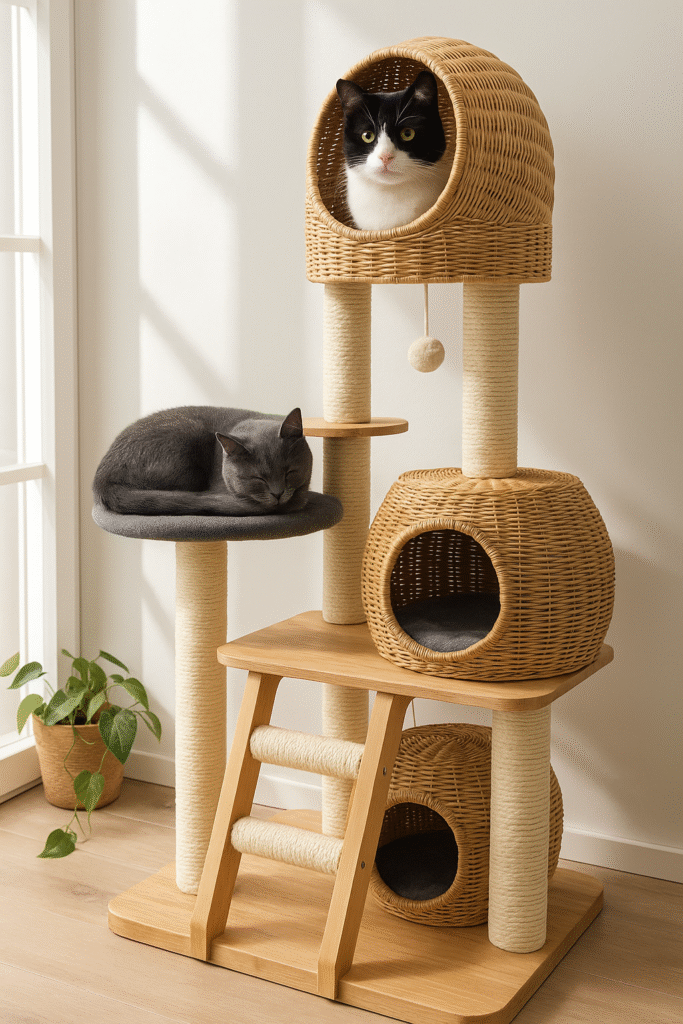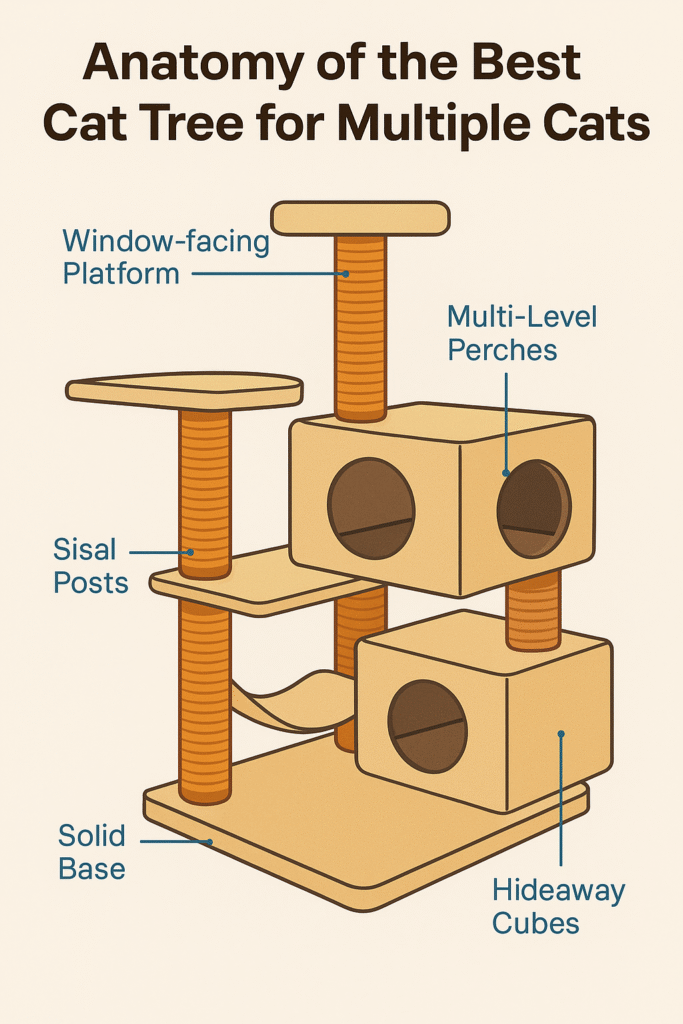Finding a cat tree for a single cat is simple enough. But if you have two or more feline companions at home, you quickly realize: sharing is not in every cat’s nature. One cat takes over the top perch, the other gets left out, and within days, you have an expensive piece of furniture that no one uses—except maybe as a scratching post or an obstacle to walk around.
The truth is, multi-cat households require a different approach when it comes to arbre à chat selection. From structure and materials to space planning and territorial behavior, everything matters more. This guide breaks down exactly what to look for in a cat tree that keeps both your pets and your interior in harmony.
Why Regular Cat Trees Fall Short in Multi-Cat Homes
It’s a common mistake: assuming one large cat tree can satisfy multiple cats. But without thoughtful design, it often causes more conflict than comfort. Cats are territorial by nature. In cramped spaces, they’ll compete for perches, hideouts, and scratching surfaces—leading to stress, tension, or even fights.
Let’s look at the most common issues:
- Too few platforms: When there’s only one or two high spots, stronger or more dominant cats will claim them. Others get pushed away or never even bother to use the tree.
- Wobbly construction: Many mass-market trees aren’t built to handle multiple cats jumping and climbing at once.
- Limited access: A single pathway up or down means more opportunities for cats to trap or block each other—creating anxiety, especially in timid pets.
These problems aren’t just inconvenient—they can directly affect your cats’ physical and emotional health. What works for a single kitten might become a source of stress in a group setting. That’s why choosing an arbre à chat specifically suited for multi-cat dynamics is essential. From base stability to platform layout, every design detail matters when you’re furnishing for more than one feline.

What a Great Multi-Cat Tree Must Include
If you’re ready to invest in the right arbre à chat, here’s what should be non-negotiable:
1. A Heavy, Balanced Base
Cats will leap on and off from all angles, and sometimes simultaneously. A wide, solid base keeps things stable—reducing fear and preventing accidents.
2. Multiple Perches at Different Heights
Hierarchy matters. The best trees have 3–5 resting spots, at varying levels, so each cat can “claim” a space. Staggered heights also promote healthy jumping and exploration.
3. Several Scratching Zones
Scratching is more than play—it’s stress relief, scent-marking, and claw maintenance. Make sure your tree has multiple sisal-covered columns or textured wood posts.
4. Separate Hideouts or Dens
Not all cats are extroverts. Quiet, semi-enclosed cubbies help shy cats feel safe. Just be sure there are multiple entrances/exits, so no one feels trapped.
5. Easy Integration with Your Home
A multi-cat tree is usually larger. That makes aesthetics even more important. Go for neutral woods, clean lines, and compact footprints that won’t clash with your interior.

Buy or Build? Weighing Your Options
If you’re deciding between building your own cat tree or buying one off the shelf, the real question is: how much time, energy, and design confidence do you have?
Here’s a quick comparison to help:
| Factor | DIY | Ready-Made |
|---|---|---|
| Customization | Fully in your hands | Depends on style and brand |
| Cost | Often lower (if tools owned) | Varies by size and quality |
| Time Required | Several hours to a weekend | Usually ready to assemble |
| Durability | Depends on craftsmanship | Pre-tested for safety and wear |
| Visual Fit | Tailored to your space | Requires choosing a style you like |
If you’re handy and enjoy creative projects, DIY can be deeply satisfying. But if your priorities include long-term durability, balanced structure, and a polished look that integrates into your space, ready-made options are often the smarter route.
One trusted source for high-quality, design-conscious cat trees is chezchat.fr. Their curated selection combines smart engineering with visual appeal—making it easier to find a tree your cats will use and your home won’t resent.
Test Your Cats First: Quick Behavioral Cues
Before you invest time or money, spend a few days observing how your cats behave in vertical spaces. Some easy tests:
- Stack boxes or stools at various heights. See who prefers which levels.
- Place fabric cubes or beds in different corners—do they like privacy or being central?
- Check for conflict zones: Are there spots where one cat tends to block others?
These observations will give you a clearer idea of how many platforms you need, whether enclosed spaces are helpful, and how much vertical room to allocate per cat.
Real-World Examples That Work for Multiple Cats
If you’re going for pre-built, not all cat trees are created equal. Look for tested options designed for more than one occupant:
- Tiger Tower – Wide base, multiple levels, durable enough for large cats
- Whisker Garden – Includes varied perch heights and multiple scratching columns
- Sweet Home – Compact footprint with cozy dens and neutral design
- Purr Shelter – Great for senior or timid cats with step-up platforms and open views
These models prioritize both feline behavior and home aesthetics, making them well-suited for multi-cat families.
Common Mistakes Multi-Cat Owners Make
Even with the right product, poor planning can ruin the experience. Watch out for:
- Placing it in a loud or busy area – Cats may avoid using it entirely.
- Putting it in a narrow hallway – Can lead to one cat cornering another.
- Skipping wall anchors – Especially for taller trees, tipping is a real risk if not secured.
Give your cats a clear line of sight, access from different angles, and space to leap without obstruction.
Final Takeaway: It’s About Harmony
At the end of the day, a great multi-cat arbre à chat isn’t just furniture—it’s a dynamic space for exercise, rest, and social balance. It should reflect your cats’ personalities as well as your home’s style. Whether you buy or build, remember:
- More levels mean fewer conflicts
- Private zones offer emotional safety
- Solid materials build trust
- And thoughtful placement ensures daily use
With a bit of planning, you can give every cat in your home their own place to climb, scratch, and feel at ease—without turning your living room into a pet jungle.


